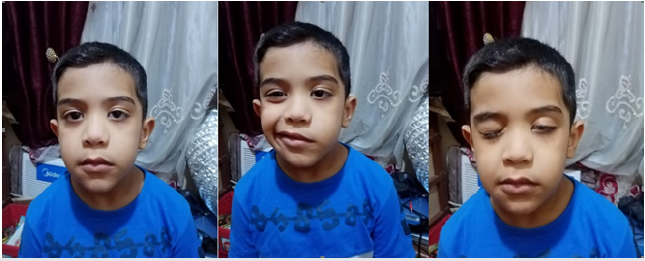
Lupine Publishers Group
Lupine Publishers
Menu
ISSN: 2637-6628
Mini Review(ISSN: 2637-6628) 
Van Der Wiel-Friedreich Idiopathic Facial Paralysis: A Case and A Brief Review of the Early Documentation of the Disorder in the Medical Literature Volume 4 - Issue 5
Aamir Jalal Al Mosawi1,2*
- 1Senior Advisor Doctor, Department of Pediatrics, Baghdad Medical City, Iraq
- 2Head, Iraq Headquarter of Copernicus Scientists International Panel, Baghdad, Iraq
Received: October 19, 2020; Published: October 30, 2020
Corresponding author: Aamir Jalal Al Mosawi, Department of Pediatrics, Baghdad Medical City, Iraq
DOI: 10.32474/OJNBD.2020.04.000196
Abstract
Background: van der Wiel-Friedreich idiopathic facial paralysis is a unilateral, partial, or complete lower motor neutron facial nerve paralysis. The weakness can be associated with mild pain, numbness. The aim of this paper is to present a case of van der Wiel-Douglas-Friedreich idiopathic facial paralysis and to describe the early documentation of the disorder in the medical literature.
Patients and Methods: The case of a six-year old boy with van der Wiel-Friedreich idiopathic facial paralysis is describe and the relevant medical literatures were reviewed to delineate accurately the early documentation of the disorder in the medical literature.
Results: The boy had lower motor neuron left facial nerve paralysis without any other neurological abnormality and was otherwise health, and no identified cause could be found (idiopathic). Based on the available evidence based-practice guideline, the boy was not given steroid therapy. Two weeks after the onset of the illness, the boy showed improvement in his condition. Review of the relevant literature showed that the condition was first described by Stalpart van der Wiel in 1686 and by Nicolaus Anton Friedreich in 1798.
Conclusion: Deep literature review showed that the valuable works of Stalpart van der Wiel and Nicolaus Anton Friedreich who provided the earliest published descriptions have been missed for centuries.
Keywords: Van Der Wiel-Friedreich Palsy; Idiopathic Facial Paralysis
Introduction
Van der Wiel-Friedreich idiopathic facial paralysis is a unilateral, partial, or complete lower motor neutron facial nerve paralysis. The weakness can be associated with mild pain, numbness. Because, the condition is typically self-limited, treatment with oral steroids within 72 hours of the onset is generally recommended for patients 16 years and older, and not for younger children. The aim of this paper is to present a case of van der Wiel-Friedreich idiopathic facial paralysis and to describe the early documentation of the disorder in the medical literature [1].
Patients and Methods
The case of a six-year old boy with van der Wiel-Friedreich idiopathic facial paralysis is describe and the relevant medical literatures were reviewed to delineate accurately the early documentation of the disorder in the medical literature.
Results
The parents of a six-year old boy noticed that their son
was developing deviation of the angle of the mouth to right side
especially during crying and laughing, and inability to close his left
eye. When first seen the boy obviously had lower motor neuron left
facial nerve paralysis with complete disappearance of the left nasolabial
fold, and he was unable to close his left eye (Figure 1A).
Based on the available evidence based-practice guideline, the
boy was not given steroid therapy. Two weeks after the onset of the illness, the boy showed improvement in his ability to close the left
eye and less deviation of the mouth (Figure 1B).
Review of the relevant literature showed that, in 1686, Stalpart
van der Wiel (Figure 2) described the occurrence of unilateral
facial paralysis of unknown causation in a married lady. The
patient complained of a twisting of her mouth from the left to the
right side. The affected side was weak and numb, and the eye on
the affected side could not be closed properly. The lady was also
drooling at one side. The condition described Stalpart van der Wiel
had rather a sudden onset and occurred shortly after exposure to
‘‘cold’’. There was emphasis that the patient experienced recovery
of the symptoms after unspecified medicinal treatment, within a
few weeks. van der Wiel also reported that the patient developed
the condition immediately post-partum [2].
Figure 1A: Early during the course of the illness, the boy had deviation of the angle of the mouth to right side with complete disappearance of the left naso-labial fold, and he was unable to close his left eye.

Figure 1B: Two weeks after the onset of the illness, the boy showed improvement in his ability to close the left eye and less deviation of the mouth.

1798, Nicolaus Anton Friedreich (1761-1836) from Germany published a thesis about idiopathic facial paralysis, and he called the condition “Rheumatic Facial Paralysis” [3].
Discussion
Lee et al (2020) studied the medical records of 53 childhood
cases of van der Wiel-Friedreich idiopathic facial paralysis. After a
mean follow-up of the patients for 30 days, thirty patients (56%)
were completely recovered, 21 patients (40%) were partially
recovered, and 2 patients (4%) had not recovered. The patients
who experienced complete recovery were significantly younger
than those who experienced partial or didn’t recover. Patients
under 8 years had a higher complete recovery rate than patients
older than 8 years old. Lee et al also found that sex, affected side,
and early or late treatment did not influence the recovery rate [4].
Clinical disorders and syndromes in medicine are generally
named after the physician or physicians that initially reported them
or provided the earliest satisfactory clinical picture or description.
However, a large number of rare syndromes have been described
throughout the world before the era of the internet which has been
associated with an easier access to medical literature. Unfortunately,
several disorders have been attributed unfairly and inappropriately
to physicians other that those first described them [5-10]. For
centuries, van der Wiel-Friedreich idiopathic facial paralysis, was
called Bell’s palsy.
Conclusion
Deep literature review showed that the valuable works of Stalpart van der Wiel and Nicolaus Anton Friedreich who provided the earliest published descriptions have been missed for centuries.
Acknowledgement
The author would like to express his gratitude for the patient for willingly accepting publishing his photos.
References
- Baugh RF, Basura GJ, Ishii LE, Schwartz SR, Drumheller CM, et al. (2013) Clinical practice guideline: Bell's palsy. Otolaryngol Head Neck Surg 149(3 Suppl): S1-27.
- Stalpart van der Wiel C (1686) First part, of the second hundred-number of the seldsame Remarks, so in the Medicine-as Hell- and Snykonst, most by eygen experience from time to time, gather, and set up. The Hague: Daniel Geselle Pp: 96-100.
- Friedreich NA (1798) About the rheumatic paralysis of the facial muscles. Journal of Inventions, Theories, and Contradictions in Natural and Medicinal Science 7: 83-95.
- Lee Y, Soo Yoon H, Yeo SG, Lee EH (2020) Factors Associated with Fast Recovery of Bell Palsy in Children. J Child Neurol 35(1): 71-76.
- Al-Mosawi AJ (2016) Mostyn Embrey syndrome. 1st ed., Saarbrücken; LAP Lambert Academic Publishing, USA.
- Al-Mosawi AJ (2016) Congenital Chevalier Jackson syndrome. 1st ed., Saarbrücken; LAP Lambert Academic Publishing, USA.
- Al-Mosawi AJ (2017) Unilateral Renal Agenesis and the Awareness of Mostyn Embrey Syndrome. Journal of Renal Medicine 1(1): 1-4.
- Al-Mosawi AJ (2017) Bequez Cesar syndrome. 1st ed., Saarbrücken; LAP Lambert Academic Publishing, USA.
- Al-Mosawi AJ (2019) The Twenty Eighth Case of Congenital Chevalier Jackson. Annals of Clinical Case Reports 4: 1-4.
- Al-Mosawi AJ (2019) The Case Number 104 of Sanjad Sakati Richardson Kirk Syndrome. Journal of Research Notes (ISSN 2641-1393) 2(2): 1-3.

Top Editors
-

Mark E Smith
Bio chemistry
University of Texas Medical Branch, USA -

Lawrence A Presley
Department of Criminal Justice
Liberty University, USA -

Thomas W Miller
Department of Psychiatry
University of Kentucky, USA -

Gjumrakch Aliev
Department of Medicine
Gally International Biomedical Research & Consulting LLC, USA -

Christopher Bryant
Department of Urbanisation and Agricultural
Montreal university, USA -

Robert William Frare
Oral & Maxillofacial Pathology
New York University, USA -

Rudolph Modesto Navari
Gastroenterology and Hepatology
University of Alabama, UK -

Andrew Hague
Department of Medicine
Universities of Bradford, UK -

George Gregory Buttigieg
Maltese College of Obstetrics and Gynaecology, Europe -

Chen-Hsiung Yeh
Oncology
Circulogene Theranostics, England -
.png)
Emilio Bucio-Carrillo
Radiation Chemistry
National University of Mexico, USA -
.jpg)
Casey J Grenier
Analytical Chemistry
Wentworth Institute of Technology, USA -
Hany Atalah
Minimally Invasive Surgery
Mercer University school of Medicine, USA -

Abu-Hussein Muhamad
Pediatric Dentistry
University of Athens , Greece

The annual scholar awards from Lupine Publishers honor a selected number Read More...





